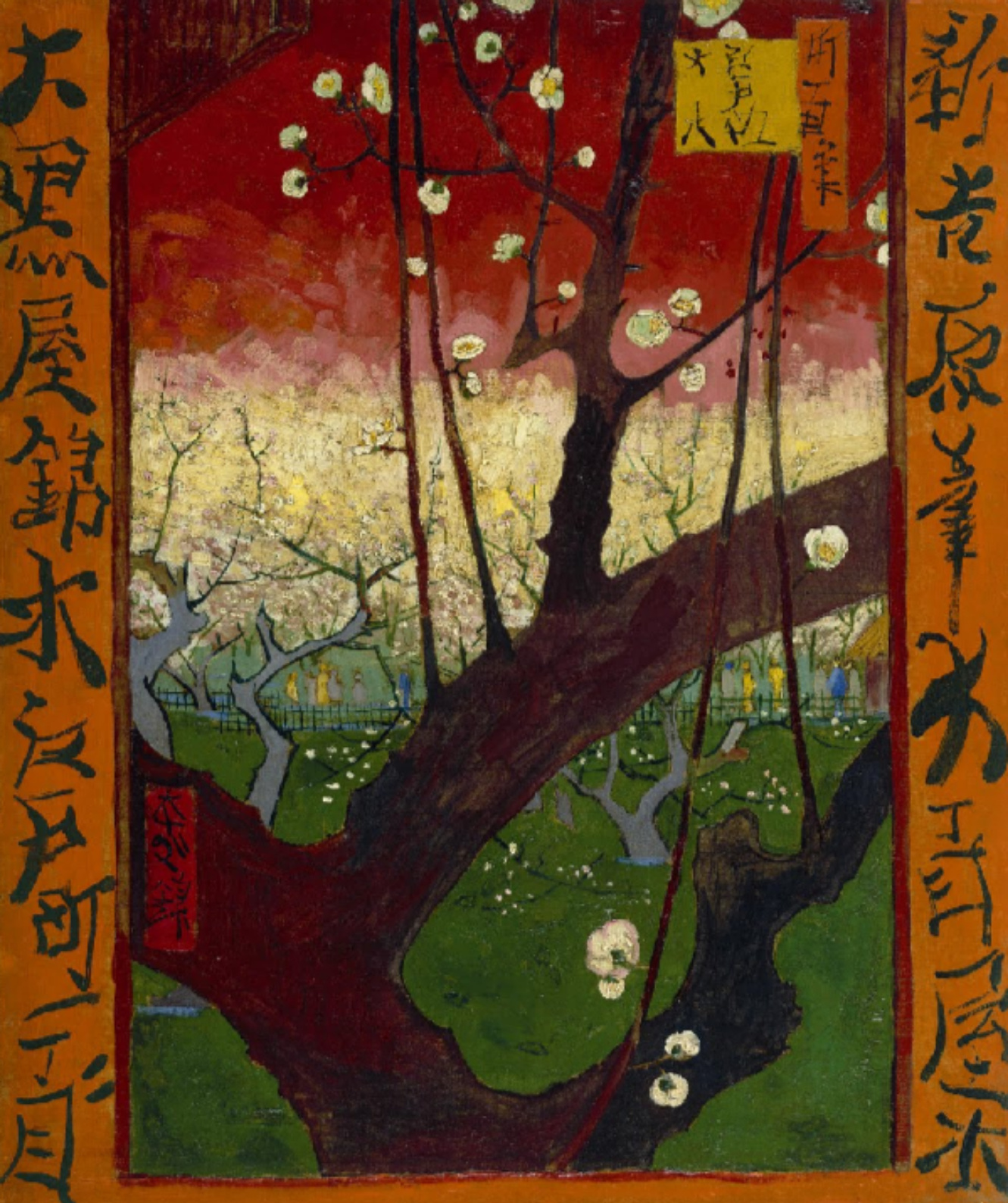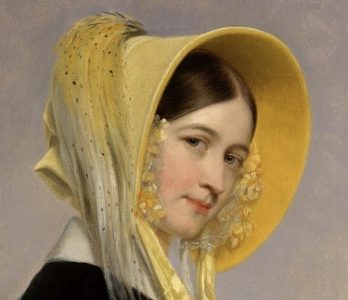“All my work is based to some extent on Japanese art…”
Vincent to his brother Theo from Arles, 15 July 1888

What did Van Gogh learn from Japanese prints?
“Van Gogh’s encounter with Japanese printmaking played a decisive role in the direction he took as an artist. During his time in Paris (1886–88), he became fascinated by ukiyo-e, nineteenth-century Japanese colour woodcuts, and began to collect them on a large scale.” (1)

Hiroshige’s ‘Flowering Plum Tree’
Hiroshige’s ‘Flowering Plum Tree’ is one of the most iconic images from his series. Van Gogh Museum writes, “The ancient plum tree … had the poetic nickname of ‘the sleeping dragon plum tree’, a name describing the branching via a network of underground roots emerging elsewhere above ground.”
According to Christie’s,
“the sky is beautifully rendered in a subtle gradient of white, pink and red, to stunning result. The garden belongs to the Kameido Tenjinsha sanctuary and the plum tree represented here was famous for its unusual shape. Known as Garyuume (resting dragon), it is mentioned in every guide of Edo, but was unfortunately lost during a flood in 1910. The tree is so described in the List of famous places in Edo: “It truly resembles a dragon laying on the ground. The branches intertwined seem to transform into a new trunk. The tree spreads to the left and right. The fragrance of its flowers eclipses that of the orchids, the vibrant white hue of the flowers, pressed tight against each other, ravishes the night.” (2)
Video
Summary of Japanese Influences:
- Bright, flat areas of color
- Bold contour lines
- Prominent diagonals
- Subjects cut off at edge of painting
- Unique use of space: emphasis on foreground and background
- High or absent horizon
- Zooming up close on details of nature
Click for Image Detail
Slideshow best viewed At Sunnyside








The Van Gogh Museum Exhibit
“With some sixty paintings and drawings by Van Gogh and a large selection of Japanese prints, the exhibition explores the extent of Van Gogh’s admiration for this form of art and the fundamental impact it had on his work.” — Van Gogh Museum
Find out more about Van Gogh and Japan at the Van Gogh Museum .
Sources
- Van Gogh Museum, Inspiration From Japan, https://www.vangoghmuseum.nl/en/stories/inspiration-from-japan , (accessed 13 Nov 2018).
- Christie’s, “Japonisme”, Paris, 15 November 2018, Lot 62, Utagawa Hiroshiga (1797-1858) Kameido Ume Yashiki (Le jardin des pruniers à Kameido) de la série Meisho Edo hyakkei (Les Cent Vues d’Edo)., https://www.christies.com/lotfinder/prints-multiples/utagawa-hiroshige-6168752-details.aspx?from=salesummery&intObjectID=6168752&sid=3d7bd3a6-19d0-4c60-a301-e8eb7460baba , (accessed 13 Nov 2018).
Thanks for Visiting 🙂
~Sunnyside

This was very informative and helpful. A real eye opener. Loved the video, the way you summarized it and also the grid pictures. Thank you for all your hard work to promote beauty and the arts.
LikeLiked by 4 people
Awww…thanks for such kind words! I really appreciate your comments 🙂
LikeLike
Very informative, Sunny. I don’t recall learning of Japanese influences on his work. The video was brief and spot on.
What a wonderful reminder: We cannot claim greatness or success for ourselves alone. Others have paved the way.
LikeLiked by 2 people
True words, Rosaliene. I am so happy you liked this. Thanks for commenting! 🙂
LikeLiked by 1 person
Wow never knew the Japanese connection of Van Gogh! Thanks for sharing!
LikeLiked by 1 person
I learned so much writing from this series. It seems many of the artists I love the most had a common admiration for Japanese art. Thanks for visiting, Tanya 🙂
LikeLiked by 1 person
its news to me as always ,never knew the contributions of Japan in fine arts!
LikeLiked by 1 person
This is brilliant ❤️
LikeLiked by 1 person
Thanks for visiting, AKwafigeria. 🙂
LikeLike
You are most welcome ❤️
LikeLiked by 1 person
really interesting! and the shamisen music has a parallel starkness to it as well.
LikeLiked by 1 person
Thanks for visiting, Rob. 🙂
LikeLiked by 1 person
Fascinating. First I’ve heard about these pieces.
LikeLiked by 1 person
Thanks for visiting, Mitch. 🙂
LikeLiked by 1 person
I have loved Van Gogh since I was a girl.
LikeLiked by 1 person
Thanks for visiting, Anna. ❤️🙂
LikeLike
Thanks for sharing useful post.
hiroshige art
LikeLiked by 1 person
Thanks for visiting, merryjones. 🙂
LikeLike